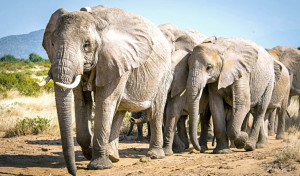African elephants listed as critically endangered amid rise in ivory demand
Posted on 29/03/2021 10:52 AM | by NaijaHouses

Following population declines over several decades due to poaching for ivory and loss of habitat, the African forest elephant (Loxodonta cyclotis) is now listed as Critically Endangered and the African savanna elephant (Loxodonta africana) as Endangered on the IUCN Red List of Threatened.
Before last week’s update, African elephants were treated as a single species, listed as vulnerable; this is the first time the two species have been assessed separately for the IUCN Red List, following the emergence of new genetic evidence.
The IUCN Red List now includes 134,425 species, of which 37,480 are threatened with extinction. The latest assessments highlight a broadscale decline in African elephant numbers across the continent. The number of African forest elephants fell by more than 86per cent over a period of 31 years, while the population of African savanna elephants decreased by at least 60 per cent over the last 50 years, according to the assessments.
Both species suffered sharp declines since 2008 due to a significant increase in poaching, which peaked in 2011 but continues to threaten populations. The ongoing conversion of their habitats, primarily to agricultural and other land uses, is another significant threat. The 2016 IUCN African Elephant Status report provides the most recent reliable estimate of the continental population of the two species combined, at around 415,000 elephants.
Despite the declining trend of both African elephant species, the assessments also highlight the impact of successful conservation efforts. Anti-poaching measures on the ground, together with more supportive legislation and land use planning which seeks to foster human-wildlife coexistence, have been key to successful elephant conservation.
As a result, some forest elephants have stabilised in well-managed conservation areas in Gabon and the Republic of the Congo. Savanna elephant numbers have also been stable or growing for decades, especially in the Kavango-Zambezi Transfrontier Conservation Area, which harbours the largest subpopulation of this species on the continent.
“Africa’s elephants play key roles in ecosystems, economies, and in our collective imagination all over the world. The new IUCN Red List assessments of both African elephant species underline the persistent pressures faced by these iconic animals,” said Dr. Bruno Oberle, IUCN Director-General.
“We must urgently put an end to poaching and ensure that sufficient suitable habitat for both forest and savanna elephants is conserved. Several African countries have led the way in recent years, proving that we can reverse elephant declines, and we must work together to ensure their example can be followed,” he said.
While the results of the assessment place the continental population of savanna elephants in the endangered category, it is important to keep in mind that at a site level, some subpopulations are thriving. For this reason, considerable caution and local knowledge are required when translating these results into policy,” said Dr. Dave Balfour, assessor of the African elephants and member of the IUCN Species Survival Commission (SSC) African Elephant Specialist Group.
The decision to treat African forest and savanna elephants as separate species is the result of the consensus that has emerged among experts following new research into the genetics of elephant populations. Forest elephants occur in the tropical forests of Central Africa and in a range of habitats in West Africa.
“They rarely overlap with the range of the savanna elephant, which prefers open country and is found in a variety of habitats in Sub-Saharan Africa including grasslands and deserts. The forest elephant, which has a more restricted natural distribution, is thought to occupy only a quarter of its historic range today, with the largest remaining populations found in Gabon and the Republic of the Congo.
For these assessments, a team of six assessors used data from as far back as the 1960s and a fully data-driven modeling approach to consolidate the decades-long efforts of many survey teams for the first time. The results quantify the dramatic extent of the decline of these ecologically important animals.
“With persistent demand for ivory and escalating human pressures on Africa’s wildlands, concern for Africa’s elephants is high, and the need to creatively conserve and wisely manage these animals and their habitats are more acute than ever,” said Dr. Kathleen Gobush, lead assessor of the African elephants and member of the IUCN SSC African Elephant Specialist Group.
The CEO of the Elephant Protection Initiative (EPI) Foundation, John Scanlon, in a statement said: “We welcome IUCN’s decision to classify the forest elephant as ‘critically endangered and will work tirelessly with our member countries to ensure its conservation.
The African forest elephant is not just a magnificent animal; it is also an important ally in our attempts to prevent catastrophic climate change. Forest elephants, by clearing smaller trees and undergrowth, allow larger and more carbon-dense trees to survive, thus enabling more carbon sequestration and storage. They are eco-system engineers.
“Moreover if we can save forest elephants, we will also be protecting one of the most biodiverse rich habitats in the world. But while the forests of west and central Africa are a natural treasure trove, we’ve learned this past year that our failure to protect them brings with it great dangers for humanity. If we carry on destroying these forests, we risk exposing humanity to zoonotic diseases and the possibility of further pandemics.”
The EPI Foundation assists countries such as Gabon, the Congo Republic, Nigeria, Liberia, Guinea, and Côte D’Ivoire to secure their national ivory stockpiles, and manage human-elephant conflict.
SOURCE: Guardian.ng